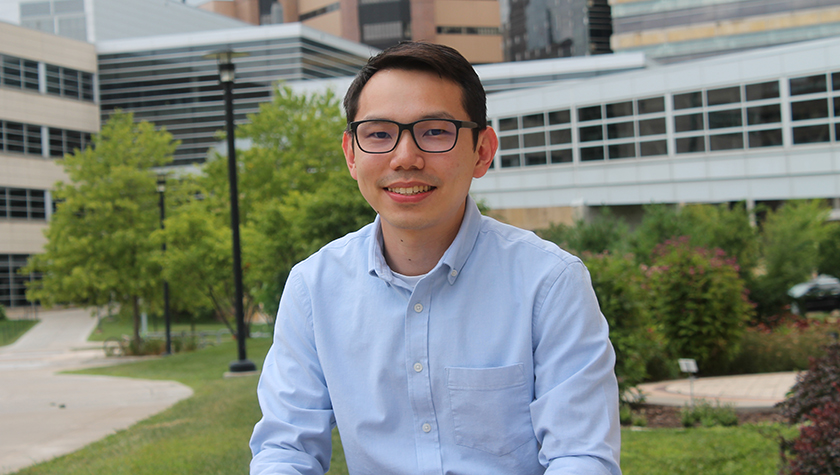
For his investigation of the optimal caffeine dosage for premature babies, School of Pharmacy Assistant Professor Sin Yin Lim is honored by the Pediatric Pharmacy Association
By Brianna Foth
Premature infants, born before 37 weeks of gestation, often face tall hurdles as their bodies struggle to adapt and mature outside the womb. Their lungs are particularly prone to complications, which can be more severe for neonates born earlier in gestation. One such complication is bronchopulmonary dysplasia (BPD), a form of chronic lung disease that results from damage to the lungs and airways, usually caused by prolonged use of oxygen or a respirator to aid breathing, which affects about 10,000 babies each year.
For his work to improve therapies to prevent BPD, Sin Yin (Sean) Lim, assistant professor in the University of Wisconsin–Madison School of Pharmacy’s Pharmacy Practice and Translational Research Division, is being awarded with the 2022 Christensen Memorial Young Investigator Award from the Pediatric Pharmacy Association (PPA). The honor is one of just three research awards granted by the PPA, and the only award it offers specifically to investigators who have been in practice for less than five years.
“I’m honored to receive this award,” says Lim. “I’m excited to show our findings, because this is a research question I know a lot of people want to know the answer to.”
“Our ultimate goal is to change how we use this medication, which is one of the most commonly used medications to treat premature babies.”
—Sin Yin Lim
For Lim’s award-winning research project, he collaborated with then-PharmD student Cynthia May (PharmD ‘22) and University of Oklahoma College of Pharmacy researchers Peter Johnson and Jamie Miller. The team investigated the use and dosing of caffeine citrate, a respiratory stimulant commonly given to treat apnea of prematurity (AOP), a respiratory condition in which newborns stop breathing for short periods of time.
AOP often occurs when the brain and muscles that keep the airway open are undeveloped as the result of a premature birth. Despite the common use of caffeine therapy to treat AOP, some babies can go on to develop BPD due to the amount of time spent receiving supplemental oxygen.
“With bronchopulmonary dysplasia, babies can develop long-term respiratory and neurological consequences,” says Lim. “But because caffeine can help to prevent all that, the next step is to find the best dose of caffeine so that we can optimize the outcomes of our premature babies.”
Lim’s research often involves pharmacokinetics simulation, a research method that uses computer modeling to simulate the interactions between drugs and the body.

“Basically, I’m trying to understand how drugs behave in the body,” says Lim. “I use that knowledge to find out how to correctly dose drugs in children, because a lot of drugs that we use in children are not well-studied.”
For the duration of the caffeine study, Lim and his fellow researchers used pharmacokinetics simulation to map how caffeine citrate was absorbed, distributed, and excreted by newborn babies at different birth weights. The simulation relied on infant growth curve data from previous literature, which the team used to calculate the pharmacokinetic parameters for newborns.
“We simulated three babies: one at a higher birth weight, one at intermediate, and one at a lower birth weight,” he says. “We followed how they grew, and then we also calculated how the pharmacokinetics changed over time. Using these calculations, we were able to see how caffeine concentration changes in the body over time.”
From the data they gathered, the research team concluded that extremely premature infants with lower birth weights might require a higher weight-based dose of caffeine, due to how quickly caffeine moved through their bodies in the simulation. With this knowledge, they hope that physicians and pharmacists will be able to administer more accurate doses, ultimately improving the health outcomes for infants with AOP and helping to prevent the development of BPD and other long-term consequences.
Having completed this project, the next step in Lim’s research will be to conduct a clinical trial to confirm the results of the simulation.
“Our ultimate goal is to change how we use this medication, which is one of the most commonly used medications to treat premature babies,” says Lim. “Ultimately, we want to improve the outcomes for these children.”